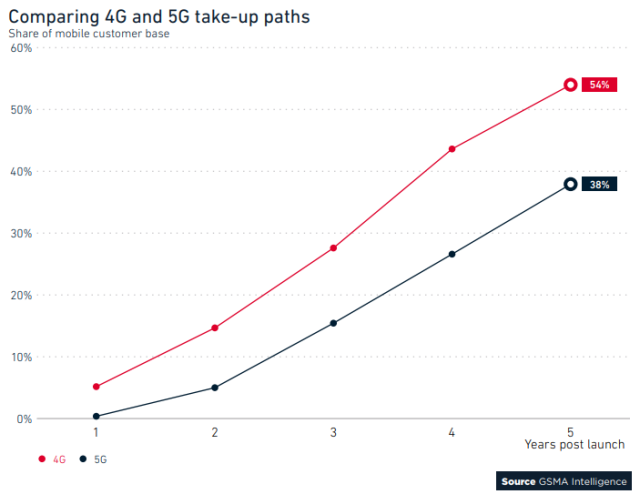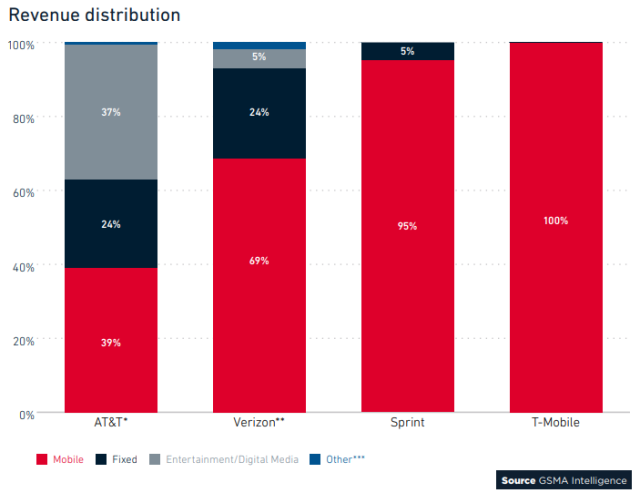GSMA has issued a new report highlighting how US telecom operators should tap retail consumers and enterprises with their 5G and IoT offerings — at the 2018 Mobile World Congress Americas.

The report indicates that US-based telecom operators’ investment in 5G, AI and IoT will help them in increasing revenue base. The report did not reveal any information on future Capex in 5G network and spectrum or return on investment from 5G.
GSMA says total Capex of US-based telecom operators will grow from $34.6 billion in 2017 to $39.1 billion in 2020 at a CAGR of 4.2 percent.
The GSMA report is also silent about 5G speeds and the impact on consumers. The earlier report from GSMA indicated that connectivity focus of 5G operators will not be alone to generate revenue from 5G.
Mobile 5G services are expected to launch later this year by AT&T and Verizon. AT&T 5G will be targeting twelve markets. Verizon 5G will be targeting four. Sprint 5G plans to launch its mobile 5G service in the first half of 2019, with nine markets announced already.
T-Mobile announced two 5G equipment deals worth $3.5 billion each with Ericsson and Nokia as part of its 5G investment strategy.
Americas region will have 260 million 5G connections or 20 percent of the global market by 2025. 5G connections globally will reach 1.3 billion by 2025, covering 40 percent of the population or approximately 2.7 billion people.
Almost half of all mobile connections in North America will be running on 5G networks by 2025, according to GSMA, suggesting that the region will migrate to 5G at a much faster rate than comparable markets in Europe and Asia.
There will be around 200 million 5G mobile connections in the US and Canada by 2025, GSMA said.

The earlier GSMA report said the planned T-Mobile-Sprint merger is likely to stabilise the US market. New revenue streams particularly from IoT and from 5G launches due from 2019 onwards should help stabilise revenue trends. The report did not reveal about the ARPU from 5G or 5G-driven IoT.
GSMA warned that consumer take-up of 5G will take time to evolve. 38 percent penetration for 5G five years after launch in 2023 will be well below 54 percent for LTE. The main opportunity for incremental operator revenues in the US will come from 5G-based fixed wireless as well as services targeted at the enterprise sector, GSMA said.
4G, which is the dominant mobile technology in North America with 70 percent of total connections in 2017, will grow until next year, when 5G will begin to make an impact.
The 5G adoption rate in North America with 49 percent of connections will be significantly ahead of Europe’s 30 percent and key Asian markets such as China, Japan and South Korea (30 percent, aggregate).
The number of IoT connections in North America is forecast to almost triple between 2018 and 2025, reaching almost 6 billion.
Intelligent Transportation
Intelligent connectivity will power transportation with the assistance of 5G networks and AI systems. 5G will communicate the location of vehicles, bicycles and people in real time, reducing the chance of accidents or collisions.
5G networks can relay data on the weather, surface conditions, road works or congestion in real time from a cyclist’s helmet. Investment in AI will help road users to select better routes. 5G systems will enhance driving by monitoring the behaviour of adjacent vehicles and responding accordingly, such as applying the brakes, as well as automatically calling for assistance in the event of accidents. 5G will also support self-driving vehicles.
“IoT is helping to pave the way towards 5G, with deployments of Low-Power Wide-Area networks on the road to massive IoT. 5G will bring opportunity in IoT, including connected cars, smart homes and cities, connected health and more. Intelligent connectivity technology will transform the way we live and work every day,” says Susan A. Johnson, executive vice president, Global Connections & Supply Chain, AT&T.
Entertainment
5G will be delivering 4K and 8K video, 3D video, holograms, augmented reality (AR) and virtual reality (VR) applications for gaming and immersive TV, as well as digital services, music and content for connected stadia.
“The investment made by the U.S. telecom industry in delivering the world’s best 5G networks is going to be key in helping to drive innovation, entrepreneurship, and future economic growth and is why we must work rapidly to support the growing demand,” said Kevin Crull, chief strategy officer at Sprint.
Drone Delivery
5G networks will enable UAVs (Unmanned Aerial Vehicles) or drones to provide fast, low-cost, secure delivery straight to customers’ homes. The network will help to coordinate large fleets, avoiding collisions with buildings and other drones as well as provide connections, authentication and smart autonomous navigation with high-definition video backup and recovery location in case of emergencies.
Baburajan K





